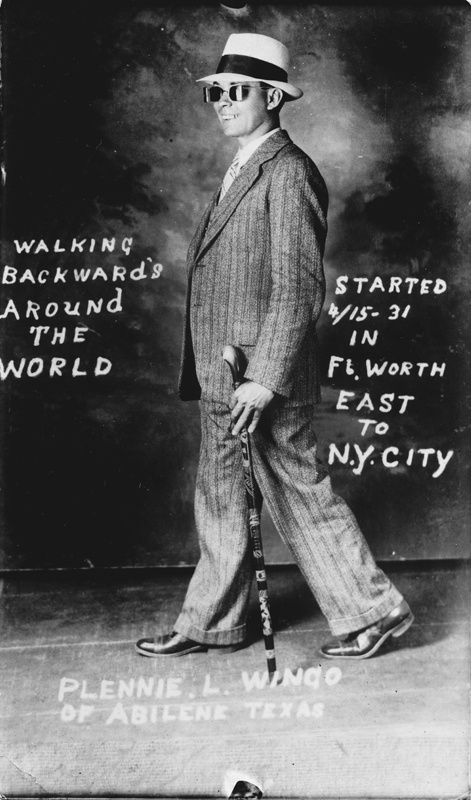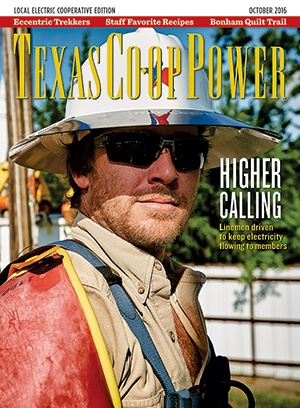Has a wave of mild insanity swept over the American people,” queried The Shamrock Texan on August 14, 1929, “or are all these things merely the result of an inordinate craving for publicity?”
Dismayed, the Panhandle editors noted the unusual behavior of a few fellow Texans. One man was rolling a hoop from Texas City to New York City. A Rio Hondo resident pushed a peanut up Pikes Peak—with his nose. Two Galvestonians, otherwise apparently sane, played a running game of croquet all the way to NYC.
As the Great Depression continued in the 1930s, the shenanigans only got worse—or more fun, depending on one’s perspective. Abilene restaurateur Plennie L. Wingo tried to walk backward around the world. San Benito produce-man Brown White advertised for someone to ride his “giant turtle” from Brownsville to New York. Though a dozen tortoise-wrangler wannabes responded, there is no evidence that anyone attempted the trip. San Benito cowboy Ralph Sanders, however, did ride a bull named Jerry from Brownsville to New York.
Bill Williams won a $500 bet when he nudged a peanut up Pikes Peak with his athletic proboscis. Williams wore out 21 pairs of gloves and custom kneepads crafted by a harness maker. The effort took 22 days and 184 peanuts.
A friend dared Texas City’s Harm Bates “Hoopie” Williams to undertake his eccentric trek. Made of steel and named Irma “for a certain girl in Texas,” Hoopie’s hoop measured 48 inches around and featured an inch-wide tread. Harm rolled her along with a bamboo pole enhanced with a steel crossbar because those specifications met the requirements of the International Association of Hoop Rollers. It took six months to roll Irma to NYC, and the hoop was 2 inches smaller afterward. Hoopie lost 15 pounds himself. In 1934, he announced that he would drive a car backward from Houston to New York, but there is no record that he actually completed the feat.
Hoopie’s backward motoring might have been inspired by the colossal reverse stroll of Wingo. Like many Americans struggling with hard times, Wingo’s Abilene restaurant was failing, and he was facing bankruptcy. Wingo explained the logic of his response to the nation’s turmoil in his 1982 autobiography, Around the World Backwards (Eakin Press, 1982). “With the whole world going backwards,” he wrote, “maybe the only way to see it was to turn around.”
Wingo bought special glasses with rearview mirrors and then commenced a rigorous training regimen with a chiropractor who had advertised that he could prepare anyone to accomplish any physical task. “He felt it was against nature and didn’t even know if it was possible,” Wingo recalled, “but he was game to help me.”
Putting his best foot backward on April 15, 1931, Wingo headed for the East Coast. He financed the trip by selling postcards along the way. At Boston Harbor, he backed ceremoniously down the gangplank to extend his trip across the Atlantic Ocean.
In Istanbul, his peculiar locomotion got him thrown in the pokey. Authorities would not allow him to continue the sojourn into Asia, so Wingo returned to the U.S. and then walked backward to Fort Worth, where he arrived on October 24, 1932. He wore out 13 pairs of shoes and lost 36 pounds.
San Benito cowboy Sanders, on the other hand, gained weight on his journey from Brownsville to New York aboard a bull named Jerry, who also bulked up while grinding down seven sets of steel shoes. After betting another cowboy that he could ride a bull to New York faster than the other cowboy could drive a goat-powered wagon, Sanders trained Jerry for 95 days before setting out on May 12, 1930. (The goatpoke gave up south of the Red River.) Two hundred fifty-four days later, Sanders rode Jerry down Broadway, presenting New York City Mayor Jimmy Walker with a 52-inch pair of steer’s horns.
“I just wanted to ride a bull,” the 28-year-old cowboy told The Associated Press. “It’s something that ain’t been done before on such a large scale. Bull riding sure is healthful, though. I feel better than I’ve felt in five years.”
——————–
Gene Fowler is an Austin writer who specializes in history and popular culture.


